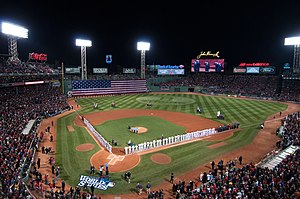
The history of sports in the United States reveals that American football, baseball, softball, and indoor soccer evolved from older British sports—rugby football, British baseball, rounders, and association football, respectively. Over time, these sports diverged significantly from their European origins, developing into distinctly American versions. For example, over time, American football developed its own rules and style, becoming distinctly different from its British predecessor and uniquely American. While baseball's origins can be traced to British bat-and-ball games such as British baseball, its development in the United States also incorporated elements from various other bat-and-ball games. Today, baseball enjoys widespread international popularity, especially in East Asia and Latin America.
In contrast, volleyball, skateboarding, snowboarding, and Ultimate Frisbee are American inventions. Volleyball was created by William G. Morgan in 1895 and has since become popular worldwide. Skateboarding, emerging in the 1950s, and snowboarding, which developed in the 1960s and 1970s, are American innovations that have gained global traction. Ultimate Frisbee, developed in the late 1960s, has also spread internationally.
Additionally, sports like lacrosse and surfing have indigenous origins. Lacrosse is rooted in Native American traditions and predates European contact, while surfing has ancient Polynesian origins and became popular in the U.S. in the early 20th century.
Precolonial era

The oldest sport invented in what is now known as the USA is lacrosse. Originating among the Indigenous peoples of the Eastern Woodlands and the Great Lakes region, lacrosse was played by various tribes and had spiritual and social significance. The game was often played in large teams and could involve hundreds of players. It was not only a sport but also a way to resolve conflicts, train warriors, and celebrate community. The American Indians had been playing lacrosse for a millennium. Similar to lacrosse, stickball was played in the Southeastern United States. It involved two teams using sticks to hit a ball, and like lacrosse, it was often played for ceremonial reasons or to settle disputes. However, the emergence of lacrosse from stickball in the 1830s led to a shift away from these values. Also, in ancient Polynesia, especially in ancient Hawaii, Polynesian people have been surfing since at least the start of the 12th century. Various Indigenous tribes engaged in running games that tested endurance and speed. These races were sometimes part of larger ceremonies or rituals.
Colonial era

In Chesapeake society (that is, colonial Virginia and Maryland), sports occupied a great deal of attention at every social level, starting at the top. In England, hunting was severely restricted to landowners. In USA, game was more than plentiful. Everyone—including servants and enslaved people—could and did hunt, so there was no social distinction to be had. In 1691, Sir Francis Nicholson, the governor of Virginia, organized competitions for the "better sort of Virginians onely who are Batchelors," and he offered prizes "to be shot for, wrastled, played at backswords, & Run for by Horse and foott." Horse racing was the main event. The typical farmer did not own a horse in the first place, and racing was a matter for gentlemen only, but ordinary farmers were spectators and gamblers. Selected slaves often became skilled horse trainers. Horse racing was especially important for knitting the gentry together. The race was a major public event designed to demonstrate to the world the superior social status of the gentry through expensive breeding, training, boasting and gambling, and especially winning the races themselves. Historian Timothy Breen explains that horseracing and high-stakes gambling were essential to maintaining the status of the gentry. When they publicly bet a large fraction of their wealth on their favorite horse, it told the world that competitiveness, individualism, and materialism were the core elements of gentry values.
Religion and sport
Christianity somewhat limited early sporting events in Colonial America as a result of dissenting reformers like the Puritans who did not hold the same views as the Anglican Church. Where the Anglican Church held positive views towards sporting events, Calvinist principles shifted the positions the reforming Protestant's held on sports. This led to more restrictive approaches to sport where the only tolerated events needed to be done "for sober, practical purposes" such as military maneuvers. It took until the late nineteenth century for this "religious prohibitionism" to flip in the opposite direction. It was then that Protestants began to see sport as having more "spiritual and moral value" which was embodied through organizations such as the Young Men's Christian Association, also known as the YMCA.
Early 19th century
Horse racing
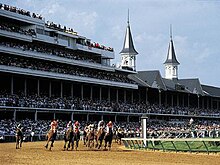
Horse racing was a prominent sport in the early 19th century, deeply rooted in American culture. Horse racing remained the leading sport in the 1780–1860 era, especially in the South. It involved owners, trainers and spectators from all social classes and both races. However, religious evangelists were troubled by the gambling dimension, and democratic elements complained that it was too aristocratic, since only the rich could own very expensive competitive horses. The Civil War devastated the wealth needed to support the sport in the South. Thoroughbred racing revived in the North in the 1870s. Elite jockey clubs operated the most prestigious racetracks. They soon faced competition from profit-oriented proprietary racetracks especially in resort towns such as Saratoga Springs New York. Gambling was legal at the track, but an even larger amount was wagered off-track by unlicensed bookies, often backed by criminal syndicates. The Kentucky Derby, inaugurated in 1875, became a major event. The Kentucky Derby is known as "The Run for the Roses." Ten Broeck was a famous racehorse in the 19th century, known for his victories and records set in various races.
Baseball
Main article: History of baseball in the United States See also: Golden age of baseball and Variations of baseball § History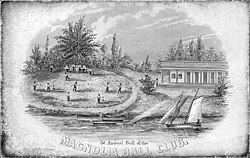
The Knickerbocker Base Ball Club, founded in 1845, set many modern rules for Baseball. Baseball evolved in New York City in the early part of the 19th century, with the first organized league, the National Association of Base Ball Players, emerging in 1857. It would eventually be the first team sport in the United States to be professionalized with the 1869 founding of the original Cincinnati Red Stockings (from whom the modern-day Cincinnati Reds took their name). By the late 19th century, baseball had become professionalized, with the National League established in 1876 as the first major professional league. Abner Doubleday often mythologized as the "inventor" of baseball, though the evidence for this claim is dubious. Alexander Cartwright a key figure in formalizing baseball rules and helping to establish the first baseball club, the Knickerbocker Base Ball Club. Cap Anson is one of the first stars of professional baseball and a key figure in its early history. The establishment of the National League (NL) in 1876 represented the formalization of professional baseball. The NL is the oldest extant major professional sports league in the United States and set many of the precedents for modern baseball.
Cricket
Main article: History of cricket in the United States
Cricket was imported from England to the United States. John Thorn, official historian of the MLB, says that in the 1850s, both cricket and baseball were considered the "national pastimes". Cricket declined in popularity after the Civil War, with baseball replacing it as the national bat-and-ball game. This decline occurred for a number of reasons; cricket was considered too long to play, requiring a few days to play, and it was resisted on nativist grounds as being of British origin, with baseball being considered a more suitable American-origin replacement.
Boxing
Boxing initially marked by unregulated, bare-knuckle matches, boxing gained structure with the Marquess of Queensberry Rules in 1867, introducing gloves and rounds. This formalization helped the sport gain wider acceptance and organization. Tom Molineaux was an early 19th-century African-American boxer who gained prominence in both American and British boxing. John L. Sullivan known as "The Boston Strong Boy," Sullivan was the first heavyweight champion of the gloved era and a major sports figure in the late 19th century.
Slave plantations
On the large slave plantations, the popular male sports were wrestling, boxing, racing, hunting, and fishing. The most popular recreations for women were dancing and singing. David Wiggins says the masters typically tolerated the slaves' pastimes as long as they were ready to work when called upon. The slave children improvised their games. Girls, for example, favored "ring dances," accompanied by songs and riddles.
Mid-19th century
The mid-19th century was a formative period for many sports in the United States, marked by the establishment of formal rules, organizations, and competitions. Rowing competitions were popular, particularly among colleges. The first collegiate rowing competition took place between Yale and Harvard in 1852. Lawn tennis began to gain popularity in the United States during the late 19th century. The first U.S. National Championships, which later became the U.S. Open, were held in 1881. Harry Wright, a prominent baseball player and manager, was instrumental in the development of baseball as a professional sport. He managed the Cincinnati Red Stockings and helped popularize the game. Al Spalding was a prominent pitcher and a key figure in the establishment of the National League.
American football
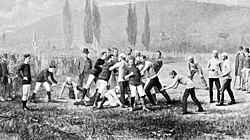
American football began with the first intercollegiate game between Princeton and Rutgers in 1869. The sport saw major changes, including the introduction of the forward pass and the establishment of the NCAA, leading to its growing popularity, especially in colleges. Walter Camp known as the "Father of American Football," Camp began influencing the game in the late 19th century by establishing many of the rules and structures that define modern football.
Basketball
Basketball invented by Dr. James Naismith in 1891 as a winter indoor activity, basketball quickly gained traction and began spreading to colleges and beyond. By the century's end, it was establishing itself in various colleges and setting the stage for future professional leagues.
Lacrosse
Lacrosse began to be organized in the U.S. in the late 19th century. It gained broader attention through college competitions and became popular in certain regions.
Late 19th
The late 19th century saw increasing debates about the commercialization and integrity of sports. Sports preferences varied by region, with baseball popular in the Northeast and football in the Midwest. Women's involvement in sports, such as tennis and golf, began to increase toward the end of the century. By the late 19th century, American sports had developed formal rules, professional leagues, and a significant national and international presence, laying the groundwork for modern sports. Richard Sears dominated American tennis in the late 19th century. He won the first seven U.S. National Championships (now the U.S. Open) from 1881 to 1887, making him one of the most successful early American tennis players. Though Francis Ouimet’s most famous achievements were in the early 20th century, his impact started in the late 19th century. He is celebrated for his victory in the 1913 U.S. Open, which is often seen as a turning point for American golf. Helen Wills Moody, though her career flourished primarily in the 1920s and 1930s, began her rise in the late 19th century. She won 31 Grand Slam titles, including 8 Wimbledon and 7 U.S. Open singles titles, making her one of the most dominant players in tennis history. Cy Young was one of the greatest pitchers in baseball history. His career spanned the 19th and early 20th centuries, and he was known for his remarkable consistency and longevity.
Early 20th century

The rise of radio and television further expanded sports' reach and influence. Baseball continued as America's pastime, with the American League forming in 1901 and stars like Babe Ruth and Ty Cobb boosting its popularity. The period saw increased integration and diversity in sports, with figures like Jackie Robinson and Wat Misaka breaking racial barriers. The NFL was established in 1920, and the sport grew rapidly, refining its rules and gaining widespread college and professional followings. Basketball gained prominence with the founding of the NBA in 1946. The sport expanded through colleges and professional leagues. The early 20th century saw boxing's golden age with stars like Jack Johnson and Joe Louis. It became a major sport with significant media attention. Golf and tennis grew in prominence, with major tournaments becoming key events. Lastly The NHL, was founded in 1917, growing in popularity, extending its reach beyond northern states. Jim Thorpe is often considered one of the greatest athletes of all time. Thorpe had a successful career in American football, playing in the early National Football League (NFL), and in professional baseball.

Moral opposition led by evangelical Protestants and social reformers led nearly all states to close their horse tracks by 1910. Much of the spectator attention shifted to automobile racing, where technology was central rather than gambling. Some tracks had both automobile and horse racing. One example was the Pennsboro Speedway, which opened for horse racing in 1887, and added automobile racing in 1926. It was the original home of the Hillbilly 100 from 1967 to 1998; the track became obsolete and closed in 2002. Horse racing made its comeback in the 1920s, as state governments legalized on-track betting which provided a welcome new flow of state revenues from a voluntary activity without imposing compulsory taxes on all citizens. By the 1950s, more people attended horse races than any other sport. Since the late 20th century, horse racing has struggled against competition from other sports and casinos. Secretariat won the Triple Crown and set records in the Kentucky Derby, Preakness Stakes, and Belmont Stakes, (1973) capturing widespread attention.
At the sixty or so historically black colleges, such as Howard University in Washington and Fisk University in Nashville, students and alumni developed a strong interest in athletics during the 1920s and 1930s. Sports were expanding rapidly at state universities, but very few black stars were recruited there. Race newspapers hailed athletic success as a demonstration of racial progress. Black schools hired coaches, recruited and featured stellar athletes, and set up their own leagues. Before 1887, the presence of black players in organized baseball was exceedingly rare. Instead, they predominantly competed in Negro league baseball, which varied in stability and caliber.
In contrast, professional American football saw more integration from its inception, encompassing diverse ethnicities including blacks, Hispanics, Native Americans (such as Olympic superstar Jim Thorpe and others from institutions like the Carlisle Indian School), and Asians. However, George Preston Marshall imposed a strict color barrier on the National Football League (NFL) from 1933 to 1946. Marshall, owner of the Washington Redskins, infamously upheld this segregationist policy until 1962, refusing to sign black players to his team despite broader integration in the sport. The NFL integration in the late 1940s came as professional football was brought to California, where college and professional teams remained fully integrated; when the NFL placed its first team (the Los Angeles Rams) in the state in 1946, it was obligated to integrate, and did so by signing college superstar Joe Aguirre and Kenny Washington.
1930s

During the New Deal of 1933–39, public sports facilities were upgraded and expanded with large sums of relief money. The CWA, WPA, and CCC were large nationwide relief projects that typically favored collaboration with local government, which often provided the plans and the site, as well as the materials and the heavy equipment, while the federal government provided the labor. Building new recreational facilities in public parks fit the model, and tens of thousands of recreation and sports facilities were built in both rural and urban areas. These projects had the main goal of providing jobs for the unemployed, but they also played to a widespread demand at the time for bodily fitness and the need for recreation in a healthy society. Roosevelt was a strong supporter of the recreation and sports dimension of his programs. The WPA spent $941 million on recreational facilities. including 5,900 athletic fields and playgrounds, 770 swimming pools, 1,700 parks, and 8,300 recreational buildings. WPA spent an additional $229 million on sports and recreational staff workers.
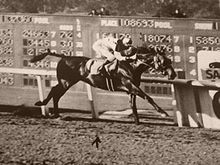
In the early 20th century, elite male and female athletes were being coached by men. Women coaches at the collegiate level developed an alternative to the highly competitive masculine model of sport in the 1920s. They created "play days" for women during which participation, cooperation, and social interaction were more the focus than victory and defeat. The motto was: ‘Play With Us, Not Against Us.’ This mode of sport also represented an effort by female administrators to obtain more control over women's athletic activity with a feminist perspective. The All-American Girls Professional Baseball League (AAGPBL) was a pioneering women's baseball league established during World War II. The league, which inspired the film "A League of Their Own," began in 1943 under the direction of Philip K. Wrigley, owner of the Chicago Cubs. It was created in response to the dwindling Major League Baseball (MLB) rosters as many players were serving in the military. The movie "A League of Their Own" provides a fictionalized portrayal of the league's history and stars, highlighting the cultural and societal norms of the era. It vividly depicts the skepticism and discrimination faced by the women athletes as they pursued their passion for baseball. Despite these challenges, the AAGPBL aimed to entertain American audiences and showcase the considerable talent of women in baseball, filling the void left by MLB during wartime. The AAGPBL served as a trailblazer for later professional women's sports leagues, laying the foundation for increased opportunities and recognition for female athletes in traditionally male-dominated sports. Its legacy continues to resonate as a testament to the determination, resilience, and skill of women who defied expectations and made history on the baseball diamond.
Mid-20th century
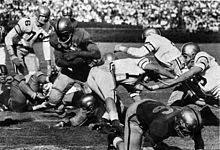
The rise of television as a major influence, significantly spring modern sports culture. Baseball continued as a major sport new stars elevating the game’s prominence. The NFL grew significantly, highlighted by the introduction of the Super Bowl in 1967. Iconic players like Johnny Unitas became central to the sport's development. The NBA expanded with stars such as Bill Russell. The NCAA Tournament gained major popularity, establishing college basketball as a significant event. Boxing remained a prominent sport with Muhammad Ali, whose career brought widespread attention and cultural impact. The NHL grew with the addition of U.S. teams and the iconic "Miracle on Ice" at the 1980 Winter Olympics, boosting the sport's popularity. Golf and tennis saw increased visibility with stars like Arnold Palmer, Jack Nicklaus, and Billie Jean King.
One of the most notable events involved the 1956 Sugar Bowl. Segregationists tried to keep Pitt fullback/linebacker Bobby Grier from playing because he was black. Georgia's governor publicly threatened the Georgia Tech's president Blake R. Van Leer to cancel the game. Ultimately, Bobby Grier played making this the first integrated Sugar Bowl and is regarded as the first integrated bowl game in the Deep South.
Manliness
Organized sports played a major role in defining new models of manliness by the mid-19th century. Boxing was professionalized, and emphasized the physical and confrontational aspects of masculinity. Bare-knuckle fighting without gloves represented "the manly art" in 19th century America. Historian Steven Elliott Tripp has explored the reaction of fans to Ty Cobb, the most dominant American baseball star of the early 20th century. He was "a player fans loved to hate," so much so that he became the pioneer sports celebrity. It was the male fans who responded enthusiastically to how Cobb demonstrated in action a new level of modern masculinity. Cobb did that by his performance as a specialist in his art, a man with iron nerve, undaunted, fighting to advance his team and his career by crushing his weaker, less-masculine opponents. Cobb demonstrated raw emotion and encouraged his audience to participate in the manly struggle underway in the stadium by shouting their taunts and jeers at the opposing team.
Late 20th century

The late 20th century saw advancements in media technology, including cable television and sports networks, which significantly increased the visibility and commercial reach of sports. The era saw greater diversity in sports, with increased participation and recognition of athletes from various backgrounds. Gender equality efforts also gained momentum, with increased opportunities for female athletes.
The late 20th century saw labor disputes, including the 1994-95 MLB strike, which temporarily disrupted the sport but eventually led to new labor agreements and increased revenue. The sport continued to thrive with iconic players like Cal Ripken Jr., known for his consecutive games streak. The NFL solidified its position as America's most popular sport with stars like Jerry Rice. The league's expansion and the introduction of new teams contributed to its growing popularity. The Super Bowl became a major cultural event, with high-profile halftime shows and significant media attention. The NBA experienced tremendous growth with the rise of stars like Michael Jordan, Magic Johnson, and Larry Bird. Jordan's Chicago Bulls dominated the 1990s, leading to increased global interest in the sport. The 1992 "Dream Team," featuring NBA stars, won the Barcelona Olympics and helped popularize basketball internationally. The NHL continued to expand, adding new teams and growing its fan base in the U.S. The Stanley Cup Finals gained increased viewership, and the league saw growth in Southern and Western U.S. markets. Tennis remained popular with stars like Andre Agassi and Chris Evert. The sport saw increased media coverage and commercial success. Golf saw a resurgence in popularity with the rise of Tiger Woods, who became a dominant force in the sport and brought increased attention and viewership.
Minorities seek a role
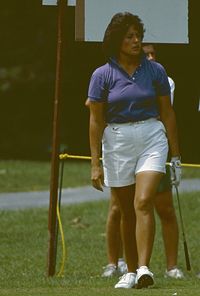
Jim Thorpe One of the greatest athletes of the early 20th century, Thorpe was of Sac and Fox descent. He excelled in football, baseball, and track and field, winning two Olympic gold medals and playing in the NFL and MLB. Billy Mills a Lakota Native American, Mills won the gold medal in the 10,000 meters at the 1964 Tokyo Olympics, making him one of the few Americans to win a gold in that event. Sandy Koufax an exceptional baseball pitcher who played for the Los Angeles Dodgers, Koufax was known for his dominance on the mound and was a three-time Cy Young Award winner. He is also noted for his decision to not pitch during Yom Kippur, reflecting his strong Jewish faith. Hank Greenberg a powerful first baseman for the Detroit Tigers, Greenberg was a two-time MVP and a key figure in Major League Baseball during the 1930s and 1940s. Jim Plunkett made history as the first Latino quarterback to win a Super Bowl, and seven years later, Doug Williams became the first black quarterback to achieve this feat. Similarly, Tom Flores broke ground as the first Latino coach to win a Super Bowl before Tony Dungy became the first black coach to do so. In the realm of boxing, Oscar De La Hoya further cemented his legacy by winning multiple world titles across different weight classes, solidifying his status as a prominent figure in the sport's storied history. Carlos Bocanegra soccer player who served as the captain of the United States national team and played professionally in Major League Soccer and Europe.
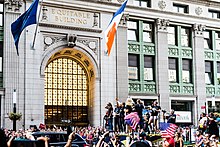
In the 20th century, women in U.S. sports achieved remarkable successes and broke significant barriers. Babe Didrikson Zaharias excelled in both track and field and golf, becoming a pioneering multi-sport athlete. Billie Jean King revolutionized tennis with 39 Grand Slam titles and a landmark victory in the "Battle of the Sexes." Wilma Rudolph became the fastest woman in the world with three gold medals at the 1960 Rome Olympics. Pat Summitt reshaped women's college basketball with the most NCAA Division I wins as a coach. Florence Griffith-Joyner set enduring world records in the 100 and 200 meters at the 1988 Olympics. Althea Gibson broke racial barriers in tennis with 11 Grand Slam titles. Nancy Lieberman made significant contributions to women's basketball both as a player and coach. Shirley Babashoff earned multiple Olympic swimming medals and was vocal about doping issues. The U.S. Women’s Soccer Team became a dominant force, winning the inaugural Women’s World Cup in 1991 and multiple titles since. These women not only excelled in their sports but also advanced the cause of gender equality in athletics. Mia Hamm is often considered the face of women's soccer and played a crucial role in popularizing the sport in the U.S. Her exceptional skill, leadership, and ability to perform in crucial moments have made her a lasting icon in the sport. Lastly, Toni Stone was a professional baseball player who played in predominantly male leagues. In 1953, she became the first woman to play as a regular on an American major-level professional baseball team
21st century

The New England Patriots, led by quarterback Tom Brady and coach Bill Belichick, won multiple Super Bowls (2001, 2003, 2004, 2014, 2016, 2018), establishing one of the most successful dynasties in NFL history. The NFL continued to expand its reach with international games in London and Mexico City, and discussions have occurred about potentially adding more teams or relocating franchises. Increased focus on player safety, including changes to tackle rules and protocols for concussion management, arose from growing awareness of chronic traumatic encephalopathy (CTE) and other long-term health issues. Golden State Warriors Dynasty: The Warriors, led by Stephen Curry, Kevin Durant, and Klay Thompson, won championships in 2015, 2017, 2018, and 2022, revolutionizing the game with their emphasis on three-point shooting. Chicago Cubs ended their 108-year championship drought by winning the World Series in 2016, a historic event that captivated fans. The use of advanced statistics and analytics has transformed team strategies, player evaluations, and game management, popularized by the “Moneyball” approach. The NHL expanded with new teams, including the Vegas Golden Knights (2017) and Seattle Kraken (2021), and saw team relocations like the Arizona Coyotes becoming the Utah Hockey Club. The NHL has increasingly featured international players, contributing to a more global game and raising the profile of hockey outside North America. Major League Soccer has seen significant growth, both in terms of expansion teams and popularity, with cities like Atlanta and Seattle becoming notable soccer hubs. The USWNT has been dominant in international women’s soccer, winning the FIFA Women’s World Cup in 2015 and 2019, and has been a leading force in advocating for gender equality in sports. The rise of esports has transformed competitive gaming into a major industry, with games like League of Legends and Fortnite attracting large audiences and significant financial investments. The market for professional sports in the United States in 2012 is $69 billion (about 50% larger than that of all of Europe, the Middle East, and Africa combined.) The rise of platforms like Twitch and major tournaments such as The International (for Dota 2) have solidified esports as a significant part of American sports culture.

Baseball has been regarded as the national sport since the late 19th century, with Major League Baseball (MLB) being the top league, while American football is now by several measures the most popular spectator sport, with the National Football League (NFL) having the highest average attendance of any sports league in the world and a Super Bowl watched by millions globally. Basketball and ice hockey are the country's leading professional team sports to be primarily played indoors, with the top leagues being the National Basketball Association (NBA) and the National Hockey League (NHL). These four major sports, when played professionally, each occupy a season at different, but overlapping, times of the year. College football and basketball attract large audiences. While not as popular as football or basketball, college baseball has a dedicated following, particularly during the NCAA Baseball Tournament and the College World Series held in Omaha, Nebraska. The Women's College World Series (WCWS) also attracting large crowds and significant television viewership. Teams from programs like Oklahoma, UCLA, and Florida often draw large fan bases. In soccer, the country hosted the 1994 FIFA World Cup and will host the 2026 FIFA World Cup, the men's national soccer team qualified to seven World Cups and the women's team has won the FIFA Women's World Cup four times; Major League Soccer is the sport's highest league in the United States. In the 21st century, soccer in the U.S. has seen significant growth, with Major League Soccer (MLS) and the National Women’s Soccer League (NWSL) becoming prominent fixtures in professional sports. while college soccer continues to serve as a key development platform for emerging talent, Women teams from schools with strong soccer programs, such as UNC, Florida State, and Stanford, have contributed to the sport's popularity. This expansion is marked by increased attendance, media coverage, and a growing fan base across both men’s and women’s soccer.

Greater media coverage and the growth of professional leagues like the WNBA and NWSL have enhanced the visibility and opportunities for female athletes. Efforts like the USWNT’s fight for equal pay and the ongoing impact of Title IX have been pivotal in advancing gender equality in sports. Female athletes are increasingly featured in media, but fewer resources compared to men’s sports, and instances of abuse have highlighted ongoing struggles. Women are making strides in coaching (Women like Becky Hammon, Kara Lawson, Kim Mulkey, Kendall Coyne), administration (Women like Kathy Carter, Heather Lyke, Cindy Parlow Cone, Linda G. Alvarado), and emerging fields like esports, though challenges remain in achieving full equity. platforms like ESPNW have emerged to focus specifically on women in sports. The NWSL, in particular, has seen increased visibility and investment, with teams like the Portland Thorns and OL Reign gaining strong followings. Serena Williams has dominated tennis and become a major advocate for gender equality. Megan Rapinoe has excelled in soccer and championed equal pay and LGBTQ+ rights. Simone Biles has set new records in gymnastics and promoted mental health awareness. Hilary Knight is widely regarded as one of the top American women’s hockey players of all time, Knight has been a dominant force in international competition and the NWHL (now PHF). She has won multiple medals with Team USA, including gold at the 2018 Winter Olympics and silver at the 2010 and 2014 Olympics. Knight is known for her exceptional scoring ability and leadership on and off the ice.
Some noticeable minorities include Alex Rodriguez an influential Major League Baseball (MLB) player of Dominican descent, Rodriguez is considered one of the greatest shortstops and third basemen in baseball history. Monica Puig Puerto Rican former professional tennis player. Javier Báez Puerto Rican MLB infielder known for his dynamic play with the Chicago Cubs and Detroit Tigers. Jeremy Lin an American-born Taiwanese basketball player known for his "Linsanity" period with the New York Knicks. A member of the Confederated Tribes of the Umatilla Indian Reservation, Shoni Schimmel is a standout in women's basketball.

Boxing and horse racing were once the most watched individual sports, but they have been eclipsed by Mixed Martial Arts (MMA) and auto racing, particularly NASCAR. The Ultimate Fighting Championship (UFC) in 1993 started showcasing various fighting styles in a cage match format, drawing initial interest. The Daytona 500 often referred to as "The Great American Race," it has been a major event in NASCAR since its inception. Richard Petty, Dale Earnhardt, and Jeff Gordon became legends in NASCAR, each contributing to the sport's rise in popularity. NASCAR's fan base has remained strong, with events like the Daytona 500 and the NASCAR Cup Series attracting large audiences. The Premier Lacrosse League PLL, founded in 2019, has attracted attention with its innovative approach to league management and high-level competition.
Nearly all sports in the United States were forced to completely halt operations during the COVID-19 pandemic in the United States beginning in March 2020. Individual sports such as golf, mixed martial arts and auto racing were the first to resume operations in May, with baseball, ice hockey and basketball following in July, without fans in attendance. The breadth and length of the cancellations was unprecedented in American history, as even during the 1918 Spanish flu pandemic, sports continued to be played with fans (only the 1919 Stanley Cup was canceled midway through due to the illness hitting one of the teams; baseball was played as normal as the peak of the flu season hit during the offseason, while football, still in its unorganized regional phase at the professional level, played reduced schedules).
Several new or emerging sports have gained traction in the USA during the 21st century. Notable examples include Pickleball Pickleball has seen rapid growth in participation and organization, with numerous local and national tournaments and a professional league, the Professional Pickleball Association (PPA), founded in 2018. Disc golf involves throwing a disc into a series of target baskets, with rules similar to traditional golf. The sport has gained a following due to its low cost and accessibility. Roller derby, a contact sport played on roller skates, has seen a resurgence in the 21st century. It is known for its fast pace, strategy, and unique team dynamics. The Women's Flat Track Derby Association (WFTDA) has helped organize and promote the sport, leading to increased visibility and participation.
Olympics
Eight Olympic Games have taken place in the United States. The United States has won 2,522 medals at the Summer Olympic Games, more than any other country, and 281 in the Winter Olympic Games, the second most behind Norway. These athletes are renowned for their exceptional performances and have set remarkable records in their respective sports Michael Phelps, Mark Spitz.
Sports in entertainment industry
Professional wrestling in the U.S. is a major entertainment industry combining athleticism with scripted storylines. WWE (World Wrestling Entertainment) is the largest and most prominent organization, known for its high-profile events like WrestleMania and widespread global reach. AEW (All Elite Wrestling) has emerged as a significant competitor, offering an alternative with its own distinct style and growing fan base. The independent wrestling scene also plays a crucial role, showcasing emerging talent and diverse wrestling styles. Overall, professional wrestling continues to captivate audiences with its unique blend of sports and entertainment. Total Nonstop Action Wrestling (TNA), now known as Impact Wrestling, is a prominent professional wrestling promotion in the U.S. Notable professional wrestlers from the U.S. include Bruno Sammartino, June Byers, Buddy Rogers, Wendi Richter, Hulk Hogan, Randy "Macho Man" Savage, Madusa, Stone Cold Steve Austin, The Rock, Sable and Mick Foley.
See also

- Sports in the United States
- History of sport
- Sociology of sport
- Major professional sports leagues in the United States and Canada
- Western physical culture
Specific sports
- Baseball in the United States
- National Basketball Association
- Cricket in the United States
- American football
- National Hockey League
- Soccer in the United States
- Volleyball in the United States
Notes
- Liss, Howard. Lacrosse (Funk & Wagnalls, 1970) pg 13.
- Hinton, R., & Sutton, K. M. Lacrosse Injuries.
- How it all Began and How it is Today – The History of Surfing. (2017, October 10). Planet Surfcamps. https://planetsurfcamps.co.uk/history-of-surfing/
- Quoted in Nancy L. Struna, "The Formalizing of Sport and the Formation of an Elite: The Chesapeake Gentry, 1650-1720s." Journal of Sport History 13#3 (1986) p 219. online Archived 2017-08-22 at the Wayback Machine
- Struna, The Formalizing of Sport and the Formation of an Elite pp 212–16.
- Timothy H. Breen, "Horses and gentlemen: The cultural significance of gambling among the gentry of Virginia." William and Mary Quarterly (1977) 34#2 pp: 239–257. online
- EDELMAN, ROBERT; Koehlinger, Amy (2020). "Chapter 32: History of Sport and Religion in the United States and Britain". OXFORD HANDBOOK OF SPORTS HISTORY. New York, NY: OXFORD UNIV Press US. pp. 491–506. ISBN 978-0-19-752095-6. OCLC 1147289853.
- Kenneth Cohen, "Well Calculated for the Farmer: Thoroughbreds in the Early National Chesapeake, 1790–1850," Virginia Magazine of History and Biography 115.3 (2007): 371–412. online
- "How Cricket Struck Out". HistoryNet. 2018-09-12. Retrieved 2023-10-01.
- Crown, Daniel (2017-10-19). "The Battle Between Baseball and Cricket for American Sporting Supremacy". Atlas Obscura. Retrieved 2020-12-14.
- Dewey, Donald (2018-09-12). "How Cricket Struck Out". HistoryNet. Retrieved 2020-12-14.
- David Wiggins, "Good Times On the Old Plantation: Popular Recreations Of The Black Slave in Antebellum South, 1810—1860." Journal of Sports History 4#3 (1977): 260–284. in JSTOR
- David K. Wiggins, "The Play of Slave Children in the Plantation Communities of the Old South." Journal of Sport History 7#2 (1980) online
- Dave Tabler, "Dirt racing at Pennsboro"
- Steven Riess, "The Cyclical History of Horse Racing: The USA's Oldest and (Sometimes) Most Popular Spectator Sport." International Journal of the History of Sport 31#1–2 (2014): 29–54.
- Patrick B. Miller, "To “bring the race along rapidly": Sport, student culture, and educational mission at historically black colleges during the interwar years." History of Education Quarterly 35#2 (1995): 111–133.
- Patrick B. Miller and David Kenneth Wiggins, eds. Sport and the color line: Black athletes and race relations in twentieth-century America (Psychology Press, 2004).
- John Wong, "FDR and the New Deal on Sport and Recreation." Sport History Review 29#2 (1998): 173–191 at p 181.
- Donald S Howard, The WPA and Federal Relief Policy, (1943) pp. 127, 130.
- Lynn E. Couturier, "‘Play With Us, Not Against Us’: The Debate About Play Days in the Regulation of Women's Sport." International Journal of the History of Sport 25#4 (2008): 421–442.
- Thamel, Pete (2006-01-01). "Grier Integrated a Game and Earned the World's Respect". New York Times. Retrieved 2009-04-15.
- Christopher David Thrasher, Fight Sports and American Masculinity: Salvation in Violence from 1607 to the Present (2015).
- Elliott J. Gorn, The Manly Art: Bare-Knuckle Prize Fighting in America (1986).
- Steven Elliott Tripp, Ty Cobb, Baseball, and American Manhood (2016) pp 256, 267.
- Hunter M. Hampton, review of Ty Cobb, Baseball, and American Manhood by Steven Elliott Tripp, in The Journal of American Culture 41#1 (2018).
- Mcg, Robert (1996-11-10). "Toni Stone, 75, First Woman To Play Big-League Baseball". The New York Times. Retrieved 2015-04-16.
- "THE Black woman of pro baseball, Toni Stone". Archived from the original on 4 August 2015. Retrieved 6 October 2014.
- Global sports market to hit $141 billion in 2012. Reuters. Retrieved on July 24, 2013.
- Krane, David K. (October 30, 2002). "Professional Football Widens Its Lead Over Baseball as Nation's Favorite Sport". Harris Interactive. Archived from the original on July 9, 2010. Retrieved September 14, 2007. MacCambridge, Michael (2004). America's Game: The Epic Story of How Pro Football Captured a Nation. New York: Random House. ISBN 0-375-50454-0.
- "Passion for College Football Remains Robust". National Football Foundation. March 19, 2013. Archived from the original on April 7, 2014. Retrieved April 1, 2014.
- Cowen, Tyler; Grier, Kevin (February 9, 2012). "What Would the End of Football Look Like?". Grantland/ESPN. Retrieved February 12, 2012.
- "As American as Mom, Apple Pie and Football? Football continues to trump baseball as America's Favorite Sport" (PDF). Harris Interactive. January 16, 2014. Archived from the original (PDF) on March 9, 2014. Retrieved July 2, 2014.
- Chase, Chris (February 7, 2014). "The 10 most fascinating facts about the all-time Winter Olympics medal standings". USA Today. Retrieved February 28, 2014. Loumena, Dan (February 6, 2014). "With Sochi Olympics approaching, a history of Winter Olympic medals". Los Angeles Times. Retrieved February 28, 2014.
Further reading
Surveys
- Daniel, Bruce. Puritans at Play: Leisure and Recreation in Colonial New England (1996) excerpt
- Eisen, George Eisen and David K. Wiggins, eds. Ethnicity and Sport in North American History and Culture (1995) excerpt, scholarly essays on Indians, Germans, Irish, Jews, blacks, Hispanics, Japanese, Italians
- Gerdy, John R. Sports: The All-American Addiction (2002) online
- Gorn, Elliott J. A Brief History of American Sports (2004)
- Jackson III, Harvey H. ed. The New Encyclopedia of Southern Culture: Sports & Recreation (2011) online
- Jay, Kathryn. More Than Just a Game: Sports in American Life since 1945 (2004). online
- Daniel, Bruce. Puritans at Play: Leisure and Recreation in Colonial New England (1996) excerpt
- Struma, Nancy L. People of Prowess: Sport, Leisure, and Labor in Early Anglo-America (1996) excerpt
- Wiggins, David K. Out of the Shadows: A Biographical History of African American Athletes (2008); focus on 20 celebrities
- Zeigler, Earle F. ed. American sport and physical education History to 1975) (1975) online
- Zeigler, Earle F. ed. History and Status of American Physical Education And Educational Sport (2005) excerpt
Specific sports
- Goldstein, Warren. Playing for keeps: A history of early baseball (Cornell University Press, 2014).
- Hoffmann, Frank, Gerhard Falk, and Martin J. Manning. Football and American identity (Routledge, 2013).
- Riess, Steven. "The Cyclical History of Horse Racing: The USA's Oldest and (Sometimes) Most Popular Spectator Sport." International Journal of the History of Sport 31#1–2 (2014): 29–54.
- Ward, Geoffrey C., and Ken Burns. Baseball: An illustrated history (1996).
Race
- Martin, Charles H. "The Rise and Fall of Jim Crow in Southern College Sports: The Case of the Atlantic Coast Conference." North Carolina Historical Review 76#3 (1999): 253–284. in JSTOR
Historiography
- Pope, S.W. ed. The new American sport history: recent approaches and perspectives (U of Illinois Press, 1997
- Zeigler, Earle F. ed. History and Status of American Physical Education And Educational Sport (2005) excerpt
Primary sources
- Wiggins, David K. and Patrick B. Miller, eds. The Unlevel Playing Field: A Documentary History of the African American Experience in Sport (2005) excerpt
Online resources
- Sports library of downloaded scholarly articles
- 828 historic photographs of American sporting events and personalities; these are pre-1923 and out of copyright.
| Sports in North America | ||
|---|---|---|
| Sovereign states |  | |
| Dependencies and other territories | ||
| Sports in the United States | |||||||||||
|---|---|---|---|---|---|---|---|---|---|---|---|
| By state / territory |
| ||||||||||
| Major team sports | |||||||||||
| Major individual sports | |||||||||||
| Minor sports | |||||||||||
| International sporting competitions | |||||||||||
| Multi-sport events | |||||||||||
| Sports governing bodies of the United States | |
|---|---|
| Summer Olympic sports | |
| Winter Olympic sports | |
| Other sports |
|